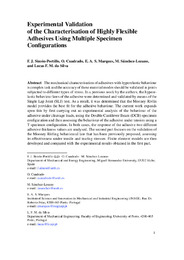Por favor, use este identificador para citar o enlazar este ítem:
https://hdl.handle.net/11000/33432Registro completo de metadatos
| Campo DC | Valor | Lengua/Idioma |
|---|---|---|
| dc.contributor.author | Simón-Portillo, Francisco J. | - |
| dc.contributor.author | Cuadrado Sempere, Óscar | - |
| dc.contributor.author | Marques, E. A. S. | - |
| dc.contributor.author | Sánchez-Lozano, Miguel | - |
| dc.contributor.author | da Silva, Lucas | - |
| dc.contributor.other | Departamentos de la UMH::Ingeniería Mecánica y Energía | es_ES |
| dc.date.accessioned | 2024-10-07T08:27:20Z | - |
| dc.date.available | 2024-10-07T08:27:20Z | - |
| dc.date.created | 2023 | - |
| dc.identifier.citation | 7th International Conference on Structural Adhesive Bonding 2023 | es_ES |
| dc.identifier.isbn | 978-3-031-48362-2 | - |
| dc.identifier.isbn | 978-3-031-48363-9 | - |
| dc.identifier.issn | 2731-0221 | - |
| dc.identifier.issn | 2731-023X | - |
| dc.identifier.uri | https://hdl.handle.net/11000/33432 | - |
| dc.description.abstract | The mechanical characterisation of adhesives with hyperelastic behaviour is complex task and the accuracy of these material modesshould be validated in joints subjected to different types of stress. In a previous work by the authors, the hyperelastic behaviour laws of the adhesive were determined and validated by means of the Single Lap Joint (SLJ) test. As a result, it was determined that the Mooney Rivlin model provides the best fit for the adhesive behaviour. The current work expands upon this by first carrying out an experimental analysis of the behaviour of the adhesive under cleavage loads, using the Double Cantilever Beam (DCB) specimen configuration and then assessing the behaviour of the adhesive under tension using a T specimen configuration. In both cases, the response of the adhesive two different adhesive thickness values are analysed. The second part focuses on the validation of the Mooney Rivling behavioural law that has been previously proposed, assessing its effectiveness under tensile and tearing stresses. Finite element models are then developed and compared with the experimental results obtained in the first part. | es_ES |
| dc.format | application/pdf | es_ES |
| dc.format.extent | 10 | es_ES |
| dc.language.iso | eng | es_ES |
| dc.publisher | Springer | es_ES |
| dc.rights | info:eu-repo/semantics/openAccess | es_ES |
| dc.rights.uri | http://creativecommons.org/licenses/by-nc-nd/4.0/ | * |
| dc.subject | Finite Element | es_ES |
| dc.subject | Hyperelastic Models | es_ES |
| dc.subject | Traction | es_ES |
| dc.subject | Peel | es_ES |
| dc.subject | Polyurethane | es_ES |
| dc.subject.other | CDU::6 - Ciencias aplicadas::62 - Ingeniería. Tecnología | es_ES |
| dc.title | Experimental Validation of the Characterisation of Highly Flexible Adhesives Using Multiple Specimen Configurations | es_ES |
| dc.type | info:eu-repo/semantics/article | es_ES |
| dc.relation.publisherversion | https://doi.org/10.1007/978-3-031-48363-9 | es_ES |

Ver/Abrir:
AB2023_Springer-PREPRINT.pdf
1,37 MB
Adobe PDF
Compartir:
 La licencia se describe como: Atribución-NonComercial-NoDerivada 4.0 Internacional.
La licencia se describe como: Atribución-NonComercial-NoDerivada 4.0 Internacional.
.png)